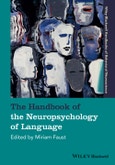- Includes contributions from an international team of leading figures in brain-language research
- Features a novel emphasis on state-of-the-art methodologies and their application to the central questions in the brain-language relationship
- Incorporates research on all parts of language, from syntax and semantics to spoken and written language
- Covers a wide range of issues, including basic level and high level linguistic functions, individual differences, and neurologically intact and different clinical populations
Table of Contents
Contributors xii
Preface xxvi
Acknowledgments (personal) xxxiv
Part 1 Language Processing in the Brain: Basic Science
Section I Language and Hemispheres: From Single-Word Recognition to Discourse 1
1 Individual Differences in Brain Organization for Language 3
Christine Chiarello, Suzanne E. Welcome, and Christiana M. Leonard
2 The Perceptual Representation of Speech in the Cerebral Hemispheres 20
Henri Cohen
3 Mechanisms of Hemispheric Specialization: Insights from Transcranial Magnetic Stimulation (TMS) Studies 41
Michal Lavidor
4 Understanding Written Words: Phonological, Lexical, and Contextual Effects in the Cerebral Hemispheres 59
Orna Peleg and Zohar Eviatar
5 The Organization of Discourse in the Brain: Results from the Item-Priming-in-Recognition Paradigm 77
Debra L. Long, Clinton L. Johns, Eunike Jonathan, and Kathleen Baynes
Section II Computational Modeling of Language 101
6 Connectionist Modeling of Neuropsychological Deficits in Semantics, Language, and Reading 103
Christine E. Watson, Blair C. Armstrong, and David C. Plaut
7 Neural Network Models of Speech Production 125
Matthew Goldrick
8 Word Learning as the Confluence of Memory Mechanisms: Computational and Neural Evidence 146
Prahlad Gupta
Section III Neural Correlates of Language Production and Comprehension 165
9 Neural Correlates of Semantic Processing in Reading Aloud 167
William W. Graves, Jeffrey R. Binder, Mark S. Seidenberg, and Rutvik H. Desai
10 In a Word: ERPs Reveal Important Lexical Variables for Visual Word Processing 184
Chia-lin Lee and Kara D. Federmeier
11 Hemodynamic Studies of Syntactic Processing 209
Peter Indefrey
12 The Neurobiology of Structure-Dependency in Natural Language Grammar 229
Marco Tettamanti and Daniela Perani
13 How Does the Brain Establish Novel Meanings in Language? Abstract Symbol Theories Versus Embodied Theories of Meaning 252
Dorothee Chwilla
14 Motor and Nonmotor Language Representations in the Brain 276
Nira Mashal, Michael Andric, and Steven Small
15 What Role Does the Cerebellum Play in Language Processing? 294
Kristina A. Kellett, Jennifer L. Stevenson, and Morton Ann Gernsbacher
Section IV Coping with Higher-Level Processing: The Brain Behind Figurative and Creative Language 317
16 Bilateral Processing and Affect in Creative Language Comprehension 319
Heather J. Mirous and Mark Beeman
17 Two-Track Mind: Formulaic and Novel Language Support a Dual-Process Model 342
Diana Van Lancker Sidtis
18 Neuropsychological and Neurophysiological Correlates of Idiom Understanding: How Many Hemispheres are Involved? 368
Cristina Cacciari and Costanza Papagno
19 Cognitive Neuroscience of Creative Language: The Poetic and the Prosaic 386
Seana Coulson and Tristan S. Davenport
20 The Brain Behind Nonliteral Language: Insights From Brain Imaging 406
Alexander Michael Rapp
21 Thinking Outside the Left Box: The Role of the Right Hemisphere in Novel Metaphor Comprehension 425
Miriam Faust
Section V The Multilingual Brain 449
22 Word Recognition in the Bilingual Brain 451
Ton Dijkstra and Walter J. B. van Heuven
23 Vocabulary Learning in Bilingual First-Language Acquisition and Late Second-Language Learning 472
Annette M. B. de Groot
24 What ERPs Tell us About Bilingual Language Processing 494
Judith F. Kroll, Taomei Guo, and Maya Misra
25 How the Brain Acquires, Processes, and Controls a Second Language 516
Jubin Abutalebi and Pasquale Anthony Della Rosa
Part 2 Language Processing in the Brain: Clinical Populations
Section I Neuropsychology of Language: Methods and Paradigms 539
26 Potentials and Paradigms: Event-Related Brain Potentials and Neuropsychology 541
Marta Kutas, Michael Kiang, and Kim Sweeney
27 What the Speaking Brain Tells us About Functional Imaging 561
John J. Sidtis
28 Uncovering the Neural Substrates of Language: A Voxel-Based Lesion–Symptom Mapping Approach 578
Juliana V. Baldo, Stephen M. Wilson, and Nina F. Dronkers
29 Analytic Methods for Single Subject and Small Sample Aphasia Research: Some Illustrations and a Discussion 591
Hiram Brownell, Ken J. Hoyte, Tepring Piquado, and Arthur Wingfield
30 Verbal Fluency Tasks and the Neuropsychology of Language 615
Seija Pekkala
Section II Neuropsychology of Language: Language Loss 631
31 The Acquisition, Retention, and Loss of Vocabulary in Aphasia, Dementia, and Other Neuropsychological Conditions 633
Andrew W. Ellis
32 Computational Neuropsychology of Language: Language Processing and its Breakdown in Aphasia 657
Stephen R. Welbourne
33 Transcranial Magnetic Stimulation and Aphasia Research 675
Margaret A. Naeser, Paula I. Martin, Michael Ho, Ethan Treglia, Elina Kaplan, Errol H. Baker, and Alvaro Pascual-Leone
34 Longitudinal Study of Recovery from Aphasia: The Case of Lexical Retrieval 696
Patricia Marinaro Fitzpatrick, Loraine K. Obler, Avron Spiro III, and Lisa Tabor Connor
35 Multiple Languages in the Adult Brain 716
Mira Goral
36 Clinical Neurolinguistics of Bilingualism 734
Andrea Marini, Cosimo Urgesi, and Franco Fabbro
37 Sentence Comprehension in Healthy and Brain-Damaged Populations 756
Sonja A. Kotz, Kathrin Rothermich, and Maren Schmidt-Kassow
38 The Neural Basis for Aging Effects on Language 774
Deborah M. Burke and Elizabeth R. Graham
Section III Neuropsychology of Language: Developmental Language Disorders 797
39 Neuropsychological and Neuroimaging Aspects of Developmental Language Disorders 799
Margaret Semrud-Clikeman and Jesse Bledsoe
40 Specific Language Impairment: Processing Deficits in Linguistic, Cognitive, and Sensory Domains 822
Laurence B. Leonard and Christine Weber-Fox
41 The Neurobiology of Specific Language Impairment 843
Richard G. Schwartz and Valerie L. Shafer
42 Dyslexia: The Brain Bases of Reading Impairments 864
Ioulia Kovelman, Joanna A. Christodoulou, and John D. E. Gabrieli
43 Acquired and Developmental Disorders of Reading and Spelling 888
Max Coltheart and Saskia Kohnen
44 The Role of Anchoring in Auditory and Speech Perception in the General and Dyslexic Populations 917
Karen Banai and Merav Ahissar
45 The Neurobiological Basis of Dyslexia: The Magnocellular Theory 934
John Stein
46 Word Retrieval in Developmental Language Impairments: Application of the Tip-of-the-Tongue Paradigm 959
Katy Borodkin and Miriam Faust
Acknowledgments 979
Index 983








